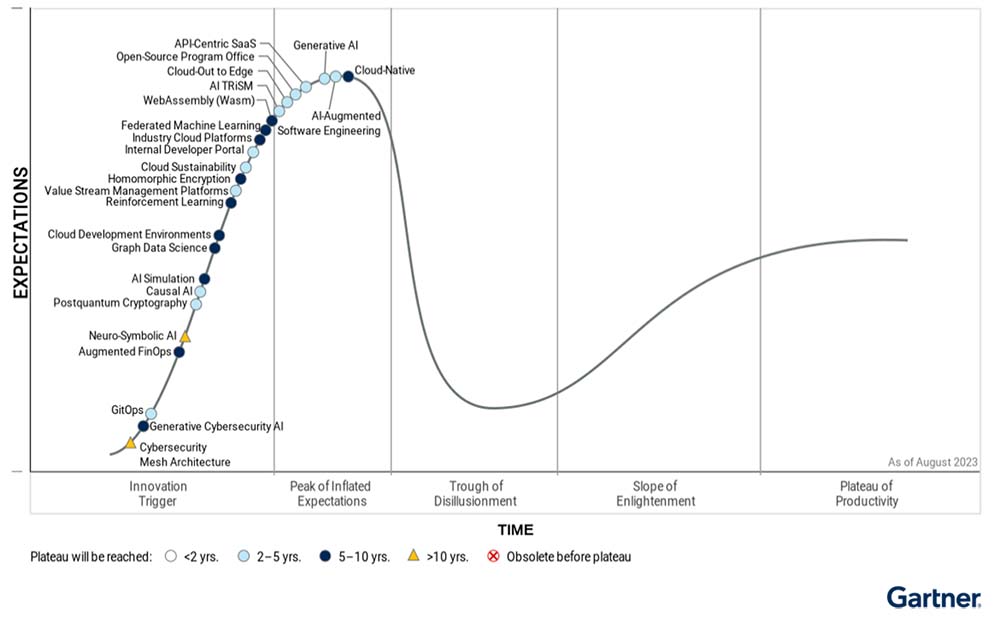Generative artificial intelligence (AI) is positioned on the Peak of Inflated Expectations on the Gartner Hype Cycle for Emerging Technologies 2023 and is expected to reach transformational benefit within two to five years.
Generative AI is encompassed within the broader theme of emergent AI, a key trend on this Hype Cycle that is creating new opportunities for innovation.
“The popularity of many new AI techniques will have a profound impact on business and society,” says Arun Chandrasekaran, distinguished VP Analyst at Gartner. “The massive pre-training and scale of AI foundation models, viral adoption of conversational agents and the proliferation of generative AI applications are heralding a new wave of workforce productivity and machine creativity.”
The Hype Cycle for Emerging Technologies is unique among Gartner Hype Cycles because it distills key insights from more than 2 000 technologies and applied frameworks that Gartner profiles each year into a succinct set of “must-know” emerging technologies. These technologies have potential to deliver transformational benefits over the next two to 10 years.
Hype Cycle for Emerging Technologies, 2023

“While all eyes are on AI right now, CIOs and CTOs must also turn their attention to other emerging technologies with transformational potential,” says Melissa Davis, vice-president analyst at Gartner. “This includes technologies that are enhancing developer experience, driving innovation through the pervasive cloud and delivering human-centric security and privacy.
“As the technologies in this Hype Cycle are still at an early stage there is significant uncertainty about how they will evolve,” adds Davis. “Such embryonic technologies present greater risks for deployment, but potentially greater benefits for early adopters.”
Emerging Technology Trend Themes
Emergent AI: In addition to generative AI, several other emerging AI techniques offer immense potential for enhancing digital customer experiences, making better business decisions, and building sustainable competitive differentiation. These technologies include AI simulation, causal AI, federated machine learning, graph data science, neuro-symbolic AI, and reinforcement learning.
Developer experience (DevX): DevX refers to all aspects of interactions between developers and the tools, platforms, processes, and people they work with to develop and deliver software products and services. Enhancing DevX is critical for most enterprises’ digital initiative success. It is also vital for attracting and retaining top engineering talent, keeping team morale high, and ensuring that work is motivating and rewarding.
Key technologies that are enhancing DevX include AI-augmented software engineering, API-centric SaaS, GitOps, internal developer portals, open-source program office, and value stream management platforms.
Pervasive cloud: Over the next 10 years, cloud computing will evolve from a technology innovation platform to become pervasive and an essential driver of business innovation. To enable this pervasive adoption, cloud computing is becoming more distributed and will be focused on vertical industries. Maximising value from cloud investments will require automated operational scaling, access to cloud-native platform tools, and adequate governance.
Key technologies enabling the pervasive cloud include augmented FinOps, cloud development environments, cloud sustainability, cloud-native, cloud-out to edge, industry cloud platforms, and WebAssembly (Wasm).
Human-centric security and privacy: Humans remain the chief cause of security incidents and data breaches. Organisations can become resilient by implementing a human-centric security and privacy programme which weaves a security and privacy fabric into the organisation’s digital design. Numerous emerging technologies are enabling enterprises to create a culture of mutual trust and awareness of shared risks in decision-making between many teams.
Key technologies supporting the expansion of human-centric security and privacy include AI TRISM, cybersecurity mesh architecture, generative cybersecurity AI, homomorphic encryption, and postquantum cryptography.
